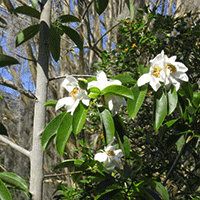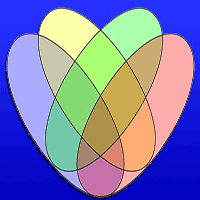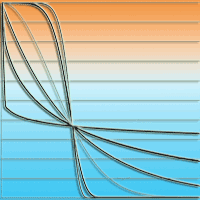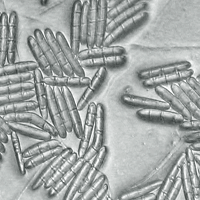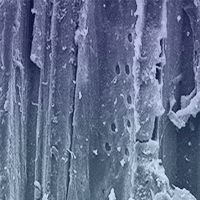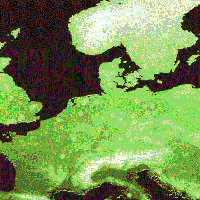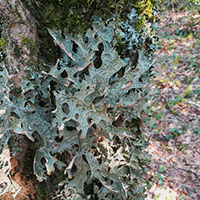Dead wood is one of the most important indicators of forest naturalness and the most important manageable habitat for biodiversity in forests. Standing and lying dead wood, and especially coarse woody debris, plays an important part in creating habitats for many highly specialized organisms, e.g., insects, fungi, lichens and bacteria. Temperate mixed deciduous forests, rich in species, have been studied only to a small extent from the point of view of the ecology of wood-related cryptogams. Our study aimed at the reduction of the gap in knowledge about the ecological characteristics of dead wood-dependent organisms by focusing on species of cryptogams developing on various dead wood structures typical of temperate non-beech forests. Studies were performed in forests located in Lithuania, Poland, Belarus and Russia. We recorded 48 species of cryptogams: 18 species of bryophytes, 24 species of fungi and 6 species of lichens developing on dead wood. Our study stresses the importance of all types of dead wood as a substrate for the development of rare cryptogam species. Logs were the most important substratum type for cryptogams, followed by snags, dead trees and stumps. The cryptogam species richness on logs was several times higher than on the three other types of substrata. Coarse logs of intermediate decay stages hosted the highest number of cryptogams, followed by freshly fallen logs and, finally, well decayed logs. Assessing the importance of dead wood quality for the studied cryptogams, we found that intermediate decay stages are extremely important for fungi, while bryophytes or lichens do not show a clear preference. The highest number of cryptogams was found on Fraxinus excelsior, Quercus robur and Picea abies, while other tree species had less than half cryptogam species.
Keywords
, , , , ,
Citation
Preikša Z, Brazaitis G, Marozas V, Jaroszewicz B (2015). Dead wood quality influences species diversity of rare cryptogams in temperate broadleaved forests. iForest 9: 276-285. - doi: 10.3832/ifor1483-008
Academic Editor
Massimo Faccoli
Paper history
Received: Oct 22, 2014
Accepted: May 18, 2015
First online: Sep 28, 2015
Publication Date: Apr 26, 2016
Publication Time: 4.43 months
© SISEF - The Italian Society of Silviculture and Forest Ecology 2015
Open Access
This article is distributed under the terms of the Creative Commons Attribution-Non Commercial 4.0 International (https://creativecommons.org/licenses/by-nc/4.0/), which permits unrestricted use, distribution, and reproduction in any medium, provided you give appropriate credit to the original author(s) and the source, provide a link to the Creative Commons license, and indicate if changes were made.

Breakdown by View Type
(Waiting for server response...)
Article Usage
Total Article Views: 52533
(from publication date up to now)
Breakdown by View Type
HTML Page Views: 43530
Abstract Page Views: 3077
PDF Downloads: 4570
Citation/Reference Downloads: 37
XML Downloads: 1319
Web Metrics
Days since publication: 3746
Overall contacts: 52533
Avg. contacts per week: 98.17
Article Citations
Article citations are based on data periodically collected from the Clarivate Web of Science web site
(last update: Mar 2025)
Total number of cites (since 2016): 20
Average cites per year: 2.00
Publication Metrics
by Dimensions ©
Articles citing this article
List of the papers citing this article based on CrossRef Cited-by.
(1)
Andersson LI, Hytteborn H (1991)Bryophytes and decaying wood - a comparison between managed and natural forest. Holarctic Ecology 14: 121-130.
CrossRef |
Gscholar
(2)
Andersson L, Kriukelis R, Ciuplys R (2002)Kertiniu miško buveiniu inventorizacijos metodika [Woodland key habitat inventory. Methodology]. Ministry of Environment Republic of Lithuania, Regional Forestry Board of Östra Götaland, Sweden, Vilnius-Linkoping, Lithuania, pp. 72. [in Lithuanian]
Gscholar
(3)
Bader P, Jannson S, Jannson BG (1995)Wood-inhabiting fungi and substrate decline in selectively logged boreal spruce forests. Biological Conservation 72: 355-362.
CrossRef |
Gscholar
(4)
Berg A, Ehnstrom B, Gustavsson L, Hallingback T, Jonsell M, Weslien J (1994)Threatened plant, animal and fungus species in Swedish forests: distribution and habitat associations. Conservation Biology 8: 718-731.
CrossRef |
Gscholar
(5)
Bobiec A (2012)Bialowieza primeval forest as a remnant of culturally modified ancient forest. European Journal of Forest Research.
CrossRef |
Gscholar
(6)
Bunce RGH, Barr CJ, Whittaker HA (1983)A stratification system for ecological sampling. In: “Ecological mapping from ground, air and space” (Fuller RM eds). ITE Symposium 10, Institute of Terrestrial Ecology, Cambridge, UK, pp. 39-46.
Online |
Gscholar
(7)
Burrascano S, Lombardi F, Marchetti M (2008)Old-growth forest structure and deadwood: are they indicators of plant species composition? A case study from central Italy. Plant Biosystems 142: 313-323.
CrossRef |
Gscholar
(8)
Chlebicki A, Zarnowiec J, Cieslinski S, Klama H, Bujakiewicz A, Zaluski T (1996)Epixylites lichenicolous fungi and their links with different kinds of wood. Phytocoenosis 8 (NS) Archivum Geobotanicum 6: 75-111.
Gscholar
(9)
Christensen M, Hahn K, Mountford EP, Odor P, Standovar T, Rozenbergar D, Diaci J, Wijdeven S, Meyer P, Winter S, Vrska T (2005)Dead wood in European beech (
Fagus sylvatica) forest reserves. Forest Ecology and Management 210: 267-282.
CrossRef |
Gscholar
(10)
Colwell RK (2013)EstimateS: statistical estimation of species richness and shared species from samples (version 9). Web site.
Online |
Gscholar
(11)
Colwell RK, Coddington JA (1994)Estimating terrestrial biodiversity through extrapolation. Philosophical Transactions of the Royal Society B 345: 101-118.
CrossRef |
Gscholar
(12)
Dahlberg A (2003)Vedlevande arters krav pa kvaliteer av dod ved [Substrate requirements of saproxylic species in Sweden]. Swedish Threatened Species Unit, Uppsala, Sweden. [in Swedish with English summary]
Gscholar
(13)
Djupstrom LB, Weslien J, Schroeder LM (2008)Dead wood and saproxylic beetles in set-aside and non set-aside forests in a boreal region. Forest Ecology and Management 255 (8-9): 3340-3350.
CrossRef |
Gscholar
(14)
Ehnstrom B, Axelsson R (2002)Insektsgnag i bark och ved [Galleries and exit holes of insects in bark and wood] Artdatabanken SLU, Uppsala, Sweden. [in Swedish with English summary]
Gscholar
(15)
Esseen PA, Ehnstrom B, Ericson L, Sjoberg K (1997)Boreal forests. Ecological Bulletin 43: 16-47.
Online |
Gscholar
(16)
Falinski JB, Mulenko W (1995)Cryptogamous plants in the forest communities of Bialowieža national park: general problems and taxonomic groups analysis. Phytocoenosis 7, Archivum geobotanicum 4, Warszawa-Bialowieza, Poland, pp. 176.
Gscholar
(17)
Fenton NJ, Bergeron Y (2008)Does time or habitat make old-growth forests species rich? Bryophyte richness in boreal
Picea mariana forests. Biological Conservation 141: 1389-1399.
CrossRef |
Gscholar
(18)
Gricius A, Matelis A (1996)Afiloforiečiai 2 [Aphyllophorales]. Mokslas ir enciklopedijos, Vilnius, Lithuania, pp. 232.
Gscholar
(19)
Gustafsson L, De Jong J, Norén M (1999)Evaluation of Swedish woodland key habitats using red-listed bryophytes and lichens. Biodiversity and Conservation 8: 1101-1114.
CrossRef |
Gscholar
(20)
Hannah L, Carr JL, Lankerani A (1995)Human disturbance and natural habitat: a biome level analysis of a global data set. Biodiversity and Conservation 4: 125-155.
CrossRef |
Gscholar
(21)
Hanski I, Kouki J, Halkka A (1993)Three explanations of the positive relationship between distribution and abundance of species. In: “Species diversity in ecological communities” (Ricklefs RE, Schluter D eds). University of Chicago Press, Chicago, IL, USA, pp. 108-116.
Gscholar
(22)
Heilmann-Clausen J, Christensen M (2004)Does size matter? On the importance of various dead wood fractions for fungal diversity in Danish beech forests. Forest Ecology and Management 201: 105-117.
CrossRef |
Gscholar
(23)
Heilmann-Clausen J, Christensen M (2005)Wood-inhabiting macrofungi in Danish beech-forests - conflicting diversity patters and their implications in a conservation perspective. Biological Conservation 122: 633-642.
CrossRef |
Gscholar
(24)
Humphrey JW, Davey S, Peace AJ, Ferris R, Harding K (2002)Lichens and bryophyte communities of planted and semi-natural forests in Britain: the influence of site type, stand structure and deadwood. Biological Conservation 107: 165-180.
CrossRef |
Gscholar
(25)
Huston MA (1996)Models and management implications of coarse wood debris impacts on biodiversity. In: Proceedings of the Workshop “Coarse Woody Debris in Southern Forests: Effects on Biodiversity” (McMinnn JW, Crossley DA eds). Athens (GA, USA) 18-20 Oct 1993. USDA Forest Service, Athens, GA, USA, pp. 139-143.
Online |
Gscholar
(26)
Iršenaite R, Kutorga E (2006)Diversity of fungi on decaying common oak coarse woody debris. Ekologija 4:22-30.
Online |
Gscholar
(27)
Jacobs JM, Spence JR, Langor DW (2007)Influence of boreal forest succession and dead wood qualities on saproxylic beetles. Agricultural and Forest Entomology 9 (1): 3-16.
CrossRef |
Gscholar
(28)
Jaeger TF (2008)Categorical data analysis: away from ANOVAs (transformation or not) and towards logit mixed models. Journal of Memory and Language 59: 434-446.
CrossRef |
Gscholar
(29)
Jukoniene I (2003)Lietuvos kiminai ir žaliosios samanos [Sphagnum and green mosses of Lithuania]. Botanikos institutas, Vilnius, Lithuania, pp. 402.
Gscholar
(30)
Juutilainen K, Halme P, Kotiranta H, Monkkonen M (2011)Size matters in studies of dead wood and wood-inhabiting fungi. Fungal Ecology 4 (5): 342-349.
CrossRef |
Gscholar
(31)
Kruys N, Fries C, Jonsson BG, Lamas T, Stahl G (1999)Wood-inhabiting cryptogams on dead Norway spruce (
Picea abies) trees in managed Swedish boreal forests. Canadian Journal of Forest Research 29: 178-186.
CrossRef |
Gscholar
(32)
Kuusinen M (1995)Epiphytic lichen diversity on Salix caprea and Populus tremula in old-growth forests of Finland. Mitt. Eidgenoss. Forsch. Anst. Wald Schnee Landsch 70: 125-132.
Online |
Gscholar
(33)
Kuusinen M (1996a)Cyanobacterial macrolichens on
Populus tremula as indicators of forest continuity in Finland. Biological Conservation 75: 43-49.
CrossRef |
Gscholar
(34)
Kuusinen M (1996b)Epiphytic lichen flora and diversity in old-growth boreal forests of Finland. Publications in Botany from the University of Helsinki 23: 1-29.
Gscholar
(35)
Kuusinen M, Siitonen J (1998)Epiphytic lichen diversity in old-growth and managed
Picea abies stands in southern Finland. Journal of Vegetation Science 9: 283-292.
CrossRef |
Gscholar
(36)
Lindblad I (1998)Wood-inhabiting fungi on fallen logs of Norway spruce: relations to forest management and substrate quality. Nordic Journal of Botany 18: 243-255.
CrossRef |
Gscholar
(37)
Lindholm M (2001)Epixyla lavar och mosssor-magfald i relation till habitets variation [Epixylic lichens and mosses - diversity in relation to habitats variation]. Masters Thesis. Goteborg University, Sweden. [in Swedish]
Gscholar
(38)
Lindenmayer DB, Margules CR, Botkin DB (2000)Indicators of biodiversity for ecologically sustainable forest management. Conservation Biology 14 (4): 941-950.
CrossRef |
Gscholar
(39)
Lohmus P, Lohmus A (2001)Snags and their lichen flora in old Estonian peatland forests. Annales Botanici Fennici 38: 265-280.
Gscholar
(40)
Lundborg A (1998)A sustainable forest fuel system in Sweden. Biomass Energy 15: 399-406.
CrossRef |
Gscholar
(41)
Malinen J, Pesonen M, Maatta T, Kajanus M (2001)Potential harvest for wood fuels (energy wood) from logging residues and first thinnings in Southern Finland. Biomass Energy 20: 189-196.
CrossRef |
Gscholar
(42)
McAlister S (1997)Cryptogam communities on fallen logs in the Duke Forest, North Carolina. Journal of Vegetation Science 8: 115-124.
CrossRef |
Gscholar
(43)
Motiejunaite J (2002)Lapiškosios ir krumiškosios kerpes [Ascomycetes lichenisati. Species foliosae et fruticosae]. Valstiečiu laikraštis, Vilnius, Lithuania, pp. 311.
Gscholar
(44)
Motiejunaite J, Czyžewska K, Cieslinski S (2004)Lichens - indicators of old-growth forests in biocentres of Lithuania and north-east Poland. Botanica Lithuanica 10 (1): 59-74.
Online |
Gscholar
(45)
Müller J, Bütler R (2010)A review of habitat thresholds for dead wood: a baseline for management recommendations in European forests. European Journal of Forest Research 129: 981-992.
CrossRef |
Gscholar
(46)
Naujalis J, Kalinauskaite N, Grinevičiene M (1995)Vadovas Lietuvos kerpems pažinti [Manual for identification of liverworts of Lithuania]. Zodynas, Vilnius, Lithuania, pp. 244.
Gscholar
(47)
Niemelä T, Renvall P, Pentilla R (1995)Interaction of fungi at late stages of wood decomposition. Annales Botanici Fennici 32: 141-150.
Gscholar
(48)
Nilsson SG, Hedin J, Niklasson M (2001)Biodiversity and its assessment in boreal and nemoral forests. Scandinavian Journal of Forest Research (Supplement 3): 10-26.
CrossRef |
Gscholar
(49)
Nitare J, Norén M (1992)Nyckelbiotoper kartläggs i nytt projekt vid Skogsstyrelsen [Key habitats identified in the new project at the National Board of Forestry]. Svensk Bot Tidskr 86: 219-226 [in Swedish with English abstract]
Gscholar
(50)
Norden B, Ryberg M, Gotmark F, Olausson B (2004)Relative importance of coarse and fine woody debris for the diversity of wood-inhabiting fungi in temperate broadleaved forests. Biological Conservation 117: 1-10.
CrossRef |
Gscholar
(51)
Odor P, Van Hees AFM (2004)Preferences of dead wood inhabiting bryophyte for decay stage, log size and habitat types in Hungarian beech forests. Journal of Bryology 26: 79-95.
CrossRef |
Gscholar
(52)
Ohlsson M, Soderstrom L, Hornberg G, Zackrisson O, Hermansson J (1997)Habitat qualities versus long-term continuity as determinants of biodiversity in boreal old-growth swamp forests. Biological Conservation 81: 221-231.
CrossRef |
Gscholar
(53)
Qian H, Klinka K, Song X (1999)Cryptogams on decaying wood in old-growth forests on southern coastal British Columbia. Journal of Vegetation Science 10: 883-894.
CrossRef |
Gscholar
(54)
Quinn GP, Keough MJ (2002)Experimental design and data analysis for biologists. Cambridge University Press, Cambridge, UK, pp. 527.
Online |
Gscholar
(55)
Peterken GF (1996)Natural woodland-ecology and conservation in northern temperate regions. Cambridge University Press, Cambridge, UK, pp. 522.
Online |
Gscholar
(56)
Ranius T, Fahrig L (2006)Targets for maintenance of dead wood for biodiversity conservation based on extinction thresholds. Scandinavian Journal of Forest Research 21: 201-208.
CrossRef |
Gscholar
(57)
Renvall P (1995)Renvall P (1995) Community structure and dynamics of wood-rotting Basidiomycetes on decomposing conifer trunks in northern Finland. Karsten 35: 1-51.
Gscholar
(58)
Rivas-Martinez S, Penas A, Diaz TE (2004)Bioclimatic map of Europe: bioclimates. Cartographic Service, University of Leon, Spain.
Online |
Gscholar
(59)
Rose F (1992)Temperate forest management: its effects on bryphyte and lichen floras and habitats. In: “Bryophytes and Lichens in a Changing Environment” (Bates JW, Farmer AM eds). Clarendon Press, Oxford, UK, pp. 211-233.
Gscholar
(60)
Samuelsson J, Gustafsson L, Ingelog T (1994)Dying and dead trees - a review of their importance for biodiversity. ArtDatabanken, Uppsala, Sweden.
Gscholar
(61)
Schielzeth H, Nakagava S (2013)Nested by design: model fitting and interpretation in a mixed model era. Methods in Ecology and Evolution 4: 14-24.
CrossRef |
Gscholar
(62)
Siitonen J (2001)Forest management, coarse woody debris and saproxylic organisms: Fennoscandian boreal forests as an example. Ecological Bulletin 49: 11-41.
Online |
Gscholar
(63)
Soderstrom L (1988)The occurrence of epixylic bryophyte and lichen species in an old natural and a managed forest stand in northeast Sweden. Biological Conservation 45: 169-178.
CrossRef |
Gscholar
(64)
Stevens V (1997)The ecological role of coarse woody debris: an overview of the ecological importance of CWD in BC forests. Working Paper 30/1997, Research Branch, BC Ministry of Forests, Victoria, British Columbia, Canada, pp. 26.
Gscholar
(65)
Svensson M, Dahlberg A, Ranius T, Thor G (2014)Dead branches on living trees constitute a large part of the dead wood in managed boreal forests, but are not important for wood-dependent lichens. Journal of Vegetation Science 25: 819-828.
CrossRef |
Gscholar
(66)
Ulicka H, Angelstam P (2000)Assessing conservation values of forest stands based on specialised lichens and birds. Biological Conservation 95: 343-351.
CrossRef |
Gscholar
(67)
Waddell KL (2002)Sampling coarse woody debris for multiple attributes in extensive resource inventories. Ecological Indicators 1: 139-153.
CrossRef |
Gscholar
(68)
Walmsley JD, Godbold DL (2010)Stump harvesting for bioenergy - a review of the environmental impacts. Forestry 83: 17-38.
CrossRef |
Gscholar


